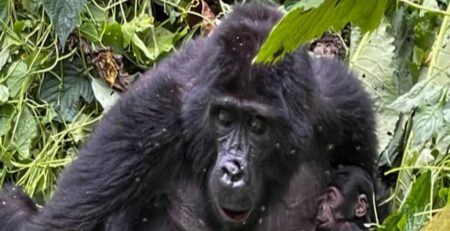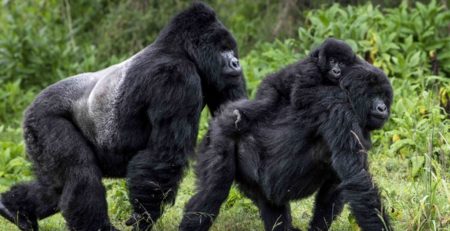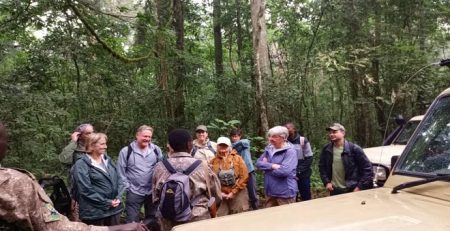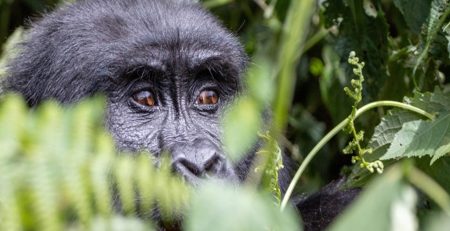Best Time for Gorilla Trekking in Uganda
Bujuku Eco Tours2025-08-27T14:57:54+03:00When is the best time for gorilla trekking in Uganda? Trekking with gorillas in Uganda is every nature lover’s dream, but many are left unsure about the best time to enjoy this adventure of gorilla trekking.
Gorilla trekking in Uganda is open to tourists at any time of the year, meaning you can travel during the dry or wet season. Gorilla trekking in Uganda is such a flexible adventure, but visitors can experience the best of this primate trek during the dry season.
Brief insight of gorilla trekking in Uganda
Gorilla trekking in Uganda is a unique experience and mainly involves searching for gorillas in the wild. The journey to see these amazing Apes involves trekking through the jungle with the park ranger guide in the lead. The length of a gorilla trek may vary, but it often takes about 2-6 hours, which includes an hour of up close and personal interaction with gorillas.
Considering the nature of this adventure, it is important to plan your trip in the right season. This can guarantee you a smooth search for gorillas. Gorilla trekking typically involves walking in the forest, and this means you should focus on the season with favorable weather conditions. As experts with extensive experience in planning successful gorilla safaris in Uganda and beyond, we recommend the dry season due to its ideal conditions.
The best time for gorilla trekking in Uganda by month
Monthly, the dry season, which is the best time for gorilla trekking in Uganda, falls into two phases. The longest dry season/months in Uganda are recorded from June, July, August, to September. The shorter dry months of the year to consider for your gorilla tours include December, January, to February.
Gorilla trekking during the wet months means you can travel anytime around the long rainy months which start from March, April, to May, or during the short wet months which occur from October to November.
December –February (2nd dry season)
December marks the start of the short dry season. These months experience low rain, and there is a higher possibility of embarking on gorilla trekking. The routes can be accessible, and forest paths won’t be slippery like it can be during the wet or rainy season.
June-September
The peak months on the Ugandan travel calendar are from June to September. In these months, there is higher concentrations of tourists confined to the gorilla safari destinations, especially in June and July. August marks the end of the peak season, an ideal period for gorilla trekking in Uganda. The month of September brings an end to the dry season. The huge crowds of tourists who come for gorilla trekking begin to reduce in September.
March-May
March marks the beginning of the longest wet or rainy season. It comes with disruption from the rains making it challenging to have a successful trek with gorillas. The heavy rain starts from March to April and reduces towards the end of May.
October-November
The shorter rainy season begins in October and runs till November. Like the long rainy months, the short wet season/months come with heavy rains. The rain showers cause disturbance during gorilla trekking. The rains begin reducing towards the end of November, welcoming in the dry month –December.
Why go for gorilla trekking in Uganda during the dry season?
Gorilla trekking in Uganda during the dry seasons comes with enormous advantages, including enjoying a smooth trek. Visitors get a chance to enjoy a smooth navigation through the jungle in search of mountain gorillas. The vegetation tends to be clearer during the dry months than during the wet season.
The clear vegetation favors photography –visitors can take great pictures of the gorilla families without disturbance from the weather. During the wet or rainy season, the vegetation tends to be denser, causing obstruction when viewing the gorillas.
The dry months allows tourist to walk through the drier terrains without any hinderance. You don’t have to worry about navigating through the jungle to see gorillas during the dry season, unlike the wet season.
Why travel to trek gorillas during the wet season?
During the wet season, the park experiences heavy rains. The heavy rainfall comes with various benefits, including high growth of vegetation. This translates to the availability of abundant food for gorillas, meaning gorillas can remain in the nearby regions to feed.
The dry season comes with prolonged drought, causing scarcity of food for gorillas to depend on. This gives the wet season a slight advantage over the dry season. As gorillas live in the nearby areas, visitors can spend fewer hours finding a group of these apes in the jungles compared to the longer hours they can take during the dry season.
Destinations for gorilla trekking in Uganda
Gorilla trekking in Uganda is conducted in Bwindi and Mgahinga National Park. These two gorilla Parks are home to over half of the world’s mountain gorillas, and they can be tracked starting from Ntebeko, Ruhija, Nkuringo, Rushaga, and Buhoma. In each of these sectors, there are some gorilla families to visit.
Buhoma sector has gorilla families like Mubare, Habinyanja, Rushegura family, and Katwe gorilla group family.
Ruhija sector has gorilla families like; Oruzogo, Bitukura, Mukiza, and Kyaguriro groups.
In the Nkuringo sector, expect to find gorilla families such as Nkuringo, Christmas, and Bushaho groups.
The biggest population of gorilla groups exists in the Rushaga sector and includes the Kutu family, Bweza, Mucunguzi, Nshongi, Busingye, Mishaya, Kahungye, Bikingi, and Rwigyi.
In Mgahinga national park, expect to embark on a journey to explore the Nyakagezi group. It is the only group officially habituated and open for trekking in Mgahinga National Park.
Weather conditions in gorilla trekking destinations
Bwindi and Mgahinga national parks experiences a tropical climate with varying heat/temperature depending on the elevation. Bwindi lies at an altitude of 1160masl to 2607masl with temperatures varying from 7 to 15 degrees Celsius and at maximum about 20-27 degrees Celsius. Overall, the average annual rainfall varies from 1400 to 1900mm. March to April, then late September to November, mark the peak rainy months of the year in Bwindi National Park.
In the mornings, temperatures tend to be moderate, varying from 7 to 20 degrees Celsius. Its lush rainforest is a major source of rainfall, and a great number of rivers are available in the forest, including River Ihihizo, Ivy River, Ntengyere, and Ishasha. These rivers flow into Lake Edward, while others feed Lake Mutanda and Bunyonyi.
Mgahinga National Park in Kisoro is at an altitude of 2227masl to 4127masl and is at the coldest part of Uganda. Temperatures can differ from 20 degrees Celsius during the day and at night, dropping to 9 degrees Celsius. The varying altitudes influence the temperatures at Mgahinga Gorilla National Park, and it is essential to be equipped when embarking on a gorilla trek in this national park.
You should carry the right gear for your gorilla safari, including a waterproof backpack, hiking boots, a rain jacket, a sweater, long-sleeved shirts, , a safari hat, a first aid kit, insect repellents, and water. The packing list should also have adequate energy-giving snacks, a good camera with additional batteries, sunscreen, and more.
If you are interested in doing gorilla trekking in Uganda, Rwanda or Congo, making bookings, getting tour guides, and drafting a gorilla trekking safari itinerary, do not hesitate to inquire from our company we shall be happy to help.












Leave a Reply